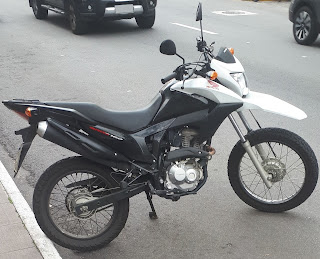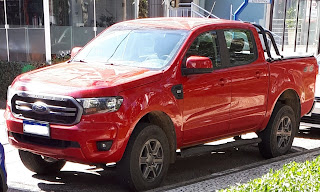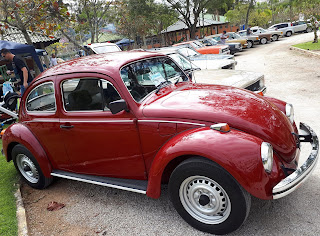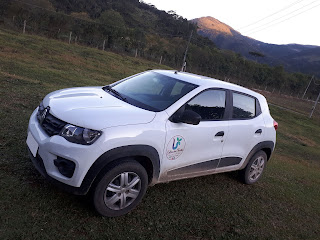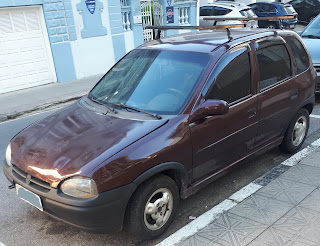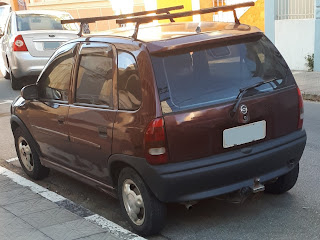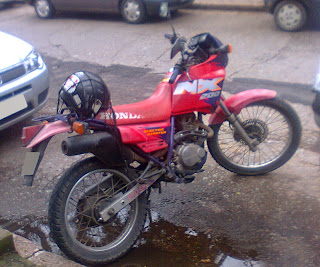Sunday, July 18, 2021
Brazilian 6-door '72 Kombi Lotação
Tuesday, July 13, 2021
Drum brakes: eventually still better suited than disc brakes under some circumstances
Among light-duty vehicles, now it's easier to find all-around drum brakes on motorcycles, even though it's now less common even in markets such as Brazil where motorcycles below 300cc are not mandated to feature ABS brakes yet. Unlike discs for which hydraulic actuation became mainstream, motorcycle brake drums are still mechanically-actuated either by cable on the front wheel or rod on the rear wheel, so with disc brakes being regarded as inherently "more prestigious" than drum brakes and motorcycles usually not featuring a parking brake there is basically no chance to incorporate hydraulic actuation to drum brakes meant for motorcycles only to make them compatible with ABS for instance. Surprisingly, the dual-purpose Honda Bros 160 nowadays relies on disc brakes all-around and is not available with drum brakes anymore, even though this setup could be better suited to some needs and preferences of many rural customers, while the Honda CG still resorts to this type of brakes for the entry-level Start version even though all the other trims now feature a front disc brake retaining the drum only to the rear wheel.
The very same lack of prestige which has rendered it not worth to develop hydraulic drum brakes for a motorcycle would not be a problem for other types of vehicles, such as pick-up trucks which became a status symbol among urban drivers instead of retaining their austere and mostly utilitarian origins. Even older models such as the Willys Jeep Pick-Up, which in Brazil soldiered on until '82 after the Brazilian branches of Willys-Overland and Ford merged, hydraulic brake systems were already mainstream, and the Jeep Pick-Up rebadged as Ford F-75 during its extended Brazilian production never got front disc brakes as a factory option, despite other light-duty trucks which were also made by Ford in Brazil being fitted with vented disc brakes in the front wheels and retaining the drum brakes only to the rear wheels. As nothing actually prevented the fitment of disc brakes, which are now a common retrofit to this and other traditional 4WD rigs among recreational drivers, possibly the F-75 being the only Ford truck with 4WD availability in Brazil at the time of its phaseout reflected a more conservative approach from rural customers who used to actually drive on harsh environments quite often.
While drum brakes all-around were not a problem for older pick-up trucks in the countryside, nowadays not even the most austere versions of their modern counterparts would be accepted by urban customers if they weren't fitted with discs at least upfront as a standard feature. A good example of such situation is the current generation of the Ford Ranger, fitted with discs all-around in the US-spec versions, while in most Latin American countries where it's sourced from Argentina it now retains the drums only in the rear-end, even though this seemingly "outdated" setup still has room for integration with modern safety features such as electronic traction and stability controls. It's also worth to point out drum brakes lead to an easier integration of a mechanically-actuated (usually by cable) parking brake, unlike disc brakes to which it's not so easy to provide a connection for a cable at the calipers, leading to the popularity of the "drum-in-hat" setup which relies on an internal concave surface built into each rear service brake disc to also serve as a drum dedicated to the parking brake in vehicles fitted with all-around disc brakes.
A quite entertaining situation which may be considered as a parameter for comparison is the VW Beetle which only had disc brakes as a standard feature in Brazil from '84 on, being taken out of production in '86 and briefly reintroduced from late-'93 to mid-'96, while in Mexico the front disc brakes only became standard in '95 before all-around drum brakes were reintroduced in a lower-trim version which lasted until '99 with front discs being standard once again until the traditional Beetle was phased out in 2003. Even though the 1600 engine having been detuned and plagued by a very restrictive exhaust required in order to address smog control issues in the Valley of Mexico, which could render its performance closer to the 1300 engine which was fitted to the last versions of the Brazilian Beetle still resorteing to the all-around drum brakes, it's also worth to remind the inherently conservative profile of the buyers at its last iterations. While the popularity of the Beetle among urban customers in Mexico only started to become threatened in the early '90s, and its phaseout was mostly dictated by the taxi regulations in Mexico City enforcing a mandate of 4-door cars rendering the "Vocho" unfit for the service, what led to a continued demand for the "Fusca" were mostly rural buyers who praised the relatively lower cost pertaining to its cross-country ability under various load conditions despite featuring only rear-wheel drive compared to 4-wheel drive models which were out-of-budget for many Brazilians (and still actually are).
While the Beetle's rear-engine and rear-wheel drive layout is now gone from the mainstream car market in Brazil, it's not uncommon for front-wheel drive models such as the Renault Kwid to be advertised as a "compact SUV" in order to attract customers who are not so willing to pay a premium for a larger and less fuel-efficient 4-wheel drive. However, as the focus of mainstream automakers for smaller cars has been more toward the so-called "urban mobility", thus neglecting actual needs of rural customers who may eventually benefit more from all-around drum brakes as they tend to not be so critically affected by corrosion than discs while exposed to agricultural fertilizers and even to the composition of the soils at different regions, it's not so likely that a regular car would feature front drum brakes again. Despite this, it's hard to deny all-around drum brakes may eventually remain better suited than disc brakes under some circumstances.
Monday, July 05, 2021
5 reasons why the Opel Corsa B ended up being quite closer to a VW Beetle replacement than any actual Volkswagen product
1 - simple mechanics: even though not so absolutely dumbproof, the Opel Corsa B has a quite simple mechanical layout. Even though it was the first of its class to feature electronic fuel injection in Brazil for the 1.0L engine, in a time when most new car buyers were still more used to consider carburettors a more straightforward option for reliability and repairability;
2 - underpinnings tougher than they may appear: the wheels noticeably smaller than the Beetle's are effectively compromising when it comes to ground clearance, but the coil-sprung front McPherson and rear twist-beam suspensions are not weaker at all. The rack-and-pinion steering gear is reliable and has a more direct responsiveness than the worm-and-gear setup fitted to the Beetle. Overall, the design of the underpinnings is actually simpler on the Corsa than on the Beetle;
3 - low running costs: with its quite simple mechanical layout and reasonable fuel consumption for a car of its age and class, the Opel Corsa B effectively took over the role of the Volkswagen Beetle during the last years of its production run in Mexico, while also being a serious contender to its reintroduction in Brazil in '93 for the '94 through '96 model-years. Even though some lower-grade versions in Europe still featured a 4-speed manual transmission with the 1.2L engine, the only manual transmission option for Mexico and Brazil was the 5-speed while the only 4-speed featured was the automatic available at a premium cost and only with the 1.6L engine;
4 - extended production runs in Brazil, Argentina and Mexico: definitely the Opel Corsa B became a favorite of buyers with a conservative profile, even though other bodystyles such as the sedan ended up outlasting the hatchback, as in Brazil where the sedan soldiered on until 2016 and in Argentina with its local production run ending up only in 2017. Mexico retained the Opel Corsa B locally badged as Chevrolet Chevy until 2012 with some controversial facelifts, while Brazil still supplied CKD kits for the hatchback until 2009 for assembly in Venezuela and South Africa;
5 - a familiar face: the bubbly design does resemble the Volkswagen Beetle somehow, even though the Opel Corsa B doesn't feature prominent fenders or running boards. But it doesn't sound like a simple coincidence that it took rounded lines for the Opel Corsa B rebadged as Chevrolet Chevy in Mexico to take over a considerable share of the local economy-car market from the Beetle.
Even though the front-wheel drive effectively doesn't allow the same off-road capabilities of a Beetle under various load conditions which interfere with the weight bias, the Opel Corsa B has proven itself a dependable commuter, addressing the requirements of many families in Latin America, while also having been a valuable asset for GM to keep a strong foothold even in regions where it retreated in more recent years.
Thursday, July 01, 2021
Brazilian Honda NX 200
Political control of prices for motorcycles below 150cc have led Honda to resort initially to a 150cc one for the first Brazilian Honda NX in '89, lately increasing it to 200cc to further differentiate performance from the CG 125. Most were converted to feature the same appearance of the Honda XR 200 nowadays, so a stock-looking NX became a rare sight in Brazil.




